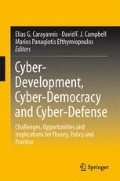Abstract
The North Atlantic Treaty Organization, (NATO)’s Smart Defence policy, results as the allied decision towards the application of the Strategic concept. Its attempt for interoperable and technological evolution of its military forces and civilian assets is the added value that makes NATO’s defence a smarter one: Agile forces command and tactical coordinated network-centric oriented operational capability. The ideological perspective of the political/legal framework is based on the necessity of a practical and renewed strategic concept. This concept was agreed initially in April of 2009 and adopted in 2010, considering the twenty-first century challenges and threats. By June 2014, NATO’s “Smart Defence” policy is the newest “brand” name that agrees to agility of military and civilian capabilities at NATO. It is being applied at all levels in an innovative management way, including in the development of a joined cyber-defence policy. Smart Defence policy orientation is concentrated among others, to the constantly increasing need for a technologically secure environment for network centric operations but also deployment of forces. Cyber-defence can be used as a core smart defence policy. A coordinated level of tactical military and civilian capability and capacity deployment in tactical symmetric or asymmetric operations. This paper provides the reader with updated information on Cyber-defence policy, Smart Defence and the North Atlantic Alliance. It is an important topic of research that can hold an impact factor in practice. This paper is an analysis paper and examination paper. It looks at the “lessons learned” to this day. It recommends issues for future capacity management, administration and fiscal costs of cyber-defence in strategic networked operations.
Access this chapter
Tax calculation will be finalised at checkout
Purchases are for personal use only
Notes
- 1.
Efthymiopoulos MP (2008) NATO’s Security Operations in Electronic Warfare: the policy of cyber-defense and the alliance new strategic concept, Australia. (Journal of Information Warfare) JIW Vol. 8, Issue 3. http://www.jinfowar.com/.
- 2.
Charter of the United Nations, Chapter VII: action with respect to threats to the peace, breaches of the peace, and acts of aggression. http://www.un.org/en/documents/charter/chapter7.shtml.
- 3.
UN Charter & NATO Atlantic Treaty, Washington DC, USA, 1949.
- 4.
NATO’s Cyber-Defense Policy (2011) http://www.nato.int/cps/en/natolive/topics_78170.htm.
- 5.
NATO Cyber-Defence Centre for Excellence. https://www.ccdcoe.org/.
- 6.
Hughes RB (2009) Atlantisch Perspectief, Ap:2009 Nr. 1/4, NATO and Cyber-Defense: Mission Accomplished, Netherlands, Netherlands Atlantic Committee.
- 7.
Ibid. 1.
- 8.
In the following sub-chapter I include the analysis of a research method to explain the meaning of Smart defense. It was presented at a conference under the name of: “The Shadow Summit of NATO’s Washington Summit of 2012”, http://www.natowatch.org/node/676 organized on May 14–15, 2012 at The Elliott School of International Affairs, The George Washington University Washington, DC. You can also see live the speech at Cspan on http://www.c-spanvideo.org/mariosefthymiopoulos.
- 9.
Sendmeyer SA (Maj) (2010) August, NATO Strategy & Out-of-Area Operations, School of Advanced Military Studies, US Army Command & General Staff College, http://www.hsdl.org/?view&did=713508.
- 10.
NATO (2008) Briefing on Transforming Allied Forces for Current and Future Operations, NATO Public Diplomacy Division, Brussels.
- 11.
Scheherazade Rehman (2013) January, Estonia’s Lessons in Cyber Warfare, US News, http://www.usnews.com/opinion/blogs/world-report/2013/01/14/estonia-shows-how-to-build-a-defense-against-cyberwarfare.
- 12.
NATO Chicago Summit: http://www.chicagonato.org/.
- 13.
“NATO Secretary General in London for talks of the Wales Summit”: http://www.nato.int/cps/en/natolive/news_106833.htm.
- 14.
Chicago Council on Global Affairs (2012) Conference: Smart Defence and the Future of NATO, Can the Alliance Meet the Challenges of the 21st Century, March 28–30 2012 Chicago Illinois, USA.
- 15.
Efthymiopoulos MP (2008) NATO in the 21st century: The need for a renewed Strategic Concept and the ever Lasting NATO-Russia relations, Athens, Thessaloniki, Published by Sakkoulas A.E. (in Greek).
- 16.
NATO (1949) NATO Treaty: Basic Document of the Treaty: http://www.nato.int/docu/basictxt/treaty.htm#Art05.
- 17.
NATO (1999) Operation Allied Force on Kosovo: http://www.nato.int/issues/kosovo_air/index.html.
- 18.
Brookings Institution (2009) Afghanistan : The Taliban Resurgent and NATO , Published by Brookings Institution, March 31 2009: http://www.brookings.edu/opinions/2006/1128globalgovernance_riedel.aspx .
- 19.
NATO (2001) International Security Assistance Force (ISAF): http://www.nato.int/isaf/index.html.
- 20.
Ibid 4.
- 21.
NATO (2001) Information on immediate NATO reaction: http://www.nato.int/docu/update/2001/0910/index-e.htm.
- 22.
Ibid 1.
- 23.
NATO Kiehl-Strasbourg Summit meeting: http://www.nato.int/cps/en/natolive/news_52837.htm?mode=pressrelease.
- 24.
Lisbon Summit Declaration: http://www.nato.int/cps/en/natolive/official_texts_68828.htm?mode=pressrelease.
- 25.
Cyber-Policy in Estonia: http://www.nato.int/cps/en/natolive/75747.htm.
- 26.
NATO Defence Ministers Meeting (2007) Informal meeting of NATO Defence Ministers: http://www.nato.int/docu/comm/2007/0710-noordwijk/0710-mod.htm.
- 27.
NATO (2008) CCDCOE, URL: from: http://www.ccdcoe.org/11.html.
- 28.
NATO NC3A (2002) NC3A Agency, URL: http://www.nc3a.nato.int/Pages/Home.aspx.
- 29.
NATO’s Cyber-Defence policy, (2008d), Defending against cyber-attacks, Focus Areas: http://www.ccdcoe.org/37.html.
- 30.
NATO (2009) A Road Map to the Strategic Concept of NATO: http://www.nato.int/strategic-concept/index.html.
- 31.
NATO (2008) NATO Defence Against Cyber Attacks: http://www.nato.int/issues/cyber_defence/practice.html.
- 32.
Ibid.
- 33.
Sharing Malware information to defeat cyber-attacks: http://www.nato.int/cps/en/natolive/news_105485.htm.
- 34.
Ibid 27.
- 35.
Ibid 29.
- 36.
NATO (2009) SPS workshop rethinks approaches to cyber security: http://www.nato.int/docu/update/2009/02-february/e0206a.html.
Author information
Authors and Affiliations
Corresponding author
Editor information
Editors and Affiliations
Rights and permissions
Copyright information
© 2014 Springer Science+Business Media New York
About this chapter
Cite this chapter
Efthymiopoulos, M.P. (2014). NATO’s Cyber-Defence: A Methodology for Smart Defence. In: Carayannis, E., Campbell, D., Efthymiopoulos, M. (eds) Cyber-Development, Cyber-Democracy and Cyber-Defense. Springer, New York, NY. https://doi.org/10.1007/978-1-4939-1028-1_12
Download citation
DOI: https://doi.org/10.1007/978-1-4939-1028-1_12
Published:
Publisher Name: Springer, New York, NY
Print ISBN: 978-1-4939-1027-4
Online ISBN: 978-1-4939-1028-1
eBook Packages: Humanities, Social Sciences and LawPolitical Science and International Studies (R0)

